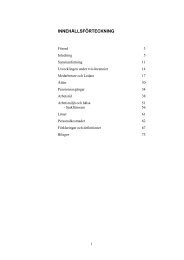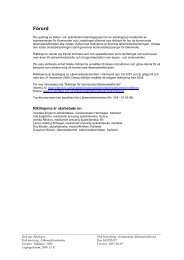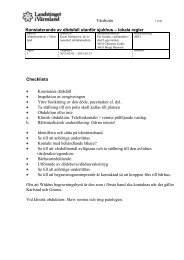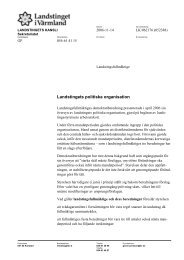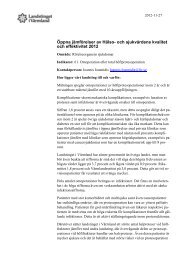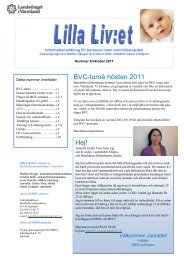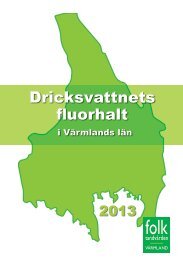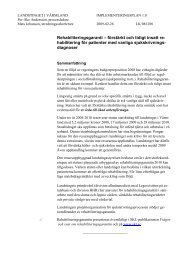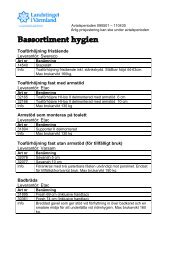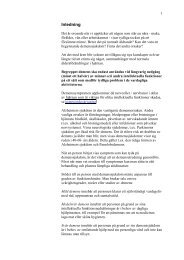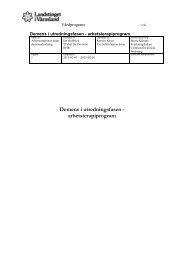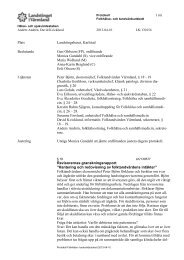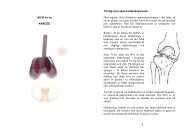Severs skada – paradigmskifte gällande diagnostik och behandling?
Severs skada – paradigmskifte gällande diagnostik och behandling?
Severs skada – paradigmskifte gällande diagnostik och behandling?
You also want an ePaper? Increase the reach of your titles
YUMPU automatically turns print PDFs into web optimized ePapers that Google loves.
Perhamre et al.<br />
Table 1. Analysis of heel pad thickness during standing bare foot vs in shoe, and without heel cup in shoe vs with heel cup<br />
body weight did not seem to affect the thickness of<br />
the heel pad standing barefoot or in shoes with or<br />
without a heel cup, even though there was a total age<br />
range of 4 years of age and a weight range of 32 kg<br />
(Table 2). There was no difference in heel pad<br />
thickness when comparing studied soccer shoes<br />
with indoor sports shoes. Comparing the heel cup<br />
group with pain with their matched controls without<br />
pain, the heel cup group showed a non-significant<br />
tendency toward thinner heel pads both bare foot<br />
and in shoe, Table 2.<br />
Peak pressure<br />
Maximal peak pressure comparing sports shoe with<br />
and without heel cup was reduced during running<br />
and standing in favor of the sports shoe with heel<br />
cup. In the statistical analysis during running the<br />
effect of heel cup treatment was significant. The<br />
multiplicative effect of heel cup was 0.79 [0.75,<br />
0.83], resulting in a reduction of heel pad peak<br />
pressure with 21% compared with the shoe without<br />
insole. Data from one child was missing, because of<br />
damage to the F-Scan sensor (n 5 9), and the last<br />
trial running including heel cup treatment was deleted<br />
due to sensor errors for one child. In the<br />
corresponding analysis of standing peak pressure,<br />
the effect of the heel cup was significant, with a<br />
multiplicative effect of 0.75 [0.72, 0.78], resulting in<br />
a reduction with 25%. There were no data missing.<br />
50<br />
n Increase in heel pad<br />
thickness, mean (mm)<br />
95 % confidence interval P-value<br />
Bare foot vs Shoe only 45 2.19 1.69<strong>–</strong>2.69 o0.001<br />
Bare foot vs Shoe with cup* 15 3.57 2.56<strong>–</strong>4.29 o0.001<br />
Shoe only vs Shoe with cup* 15 1.53 0.63<strong>–</strong>2.23 5 0.002<br />
*Treatment group only.<br />
Fig. 3. Radiographic assessment of heel pad thickness when standing on heel in shoe without cup (left) and with heel cup<br />
(right). The most painful heel was investigated and the distance from vertex calcanei and the skin reference mark was measured.<br />
Note how the cup restores soft tissue thickness. The difference in heel pad thickness was in this case 1.95 mm.<br />
4<br />
Table 2. Heel pad thickness in different subgroups<br />
Heel pad thickness during standing,<br />
mean (mm)<br />
Bare<br />
foot<br />
Sports<br />
shoe<br />
Shoe with<br />
cup*<br />
Age<br />
9<strong>–</strong>10 years (n 5 10) 6.86 8.55 10.66<br />
11<strong>–</strong>12 years (n 5 29) 6.35 8.47 9.77<br />
13<strong>–</strong>14 years (n 5 2) 8.02 11.52 11.94<br />
Body weight<br />
30<strong>–</strong>37 kg (n 5 15) 6.30 8.31 9.43<br />
38<strong>–</strong>47 kg (n 5 15) 6.82 8.88 11.09<br />
48<strong>–</strong>62 kg (n 5 15) 6.85 9.47 10.4<br />
Type of sports shoe<br />
Soccer shoes (n 5 23) 6.66 8.93 10.12<br />
Indoor shoes (n 5 22) 6.79 8.90 10.18<br />
Cup treated (group I) 6.51 8.83 10.37<br />
No treatment (group II) 7.13 9.22 <strong>–</strong><br />
Controls (group III) 7.00 9.42 <strong>–</strong><br />
*Treatment group only.<br />
Table 3 shows the mean values in mmHg in running<br />
and standing. Figure 4 shows one typical example of<br />
maximal peak pressure measurement.<br />
Pain relief<br />
Table 4 shows a significant pain reduction in sport<br />
activities in the treated group during the study<br />
period. There was an immediate reduction of pain



